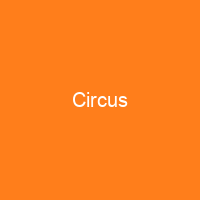A circus is a company of performers who put on diverse entertainment shows that may include clowns, acrobats, trained animals, trapeze acts, musicians, dancers, hoopers, tightrope walkers, jugglers, magicians, unicyclists. The term circus also describes the performance which has followed various formats through its 250-year modern history. The traditional format, in which a ringmaster introduces a variety of choreographed acts set to music, developed in the latter part of the 19th century and remained the dominant format until the 1970s.
About Circus in brief

Some historians such as George Speaight have stated that circus-related entertainment can be traced to the Roman Hippodrome of Constantinople. Others have argued that the lineage of modern circus does go back to the ancient Roman circuses and a chronology of circus events. The circus was the only public spectacle at which men and women were not separated at the giver of the spectacle at the time of the Roman circus. It is not a mistake to equate the circus with the places, or places, that were called ‘circuses’ by the Romans, but it is the entertainments that were presented, or the places or entertainments presented, with the circus, not the other way around. The word circus derives from Latin circus, which is the romanization of the Greek κίρκos, meaning ‘circle’ or ‘ring’. The earliest modern circuses were performed in open-air structures with limited covered seating. From the late 18th to late 19th Century, custom-made circus buildings were built with various types of seating, a centre ring, and sometimes a stage. These tents eventually became the most common venue. Many circus performances are still held in a ring, usually 13 m in diameter. This dimension was adopted by Astley in theLate 18th century as the minimum diameter that enabled an acrobatic horse rider to stand upright on a cantering horse to perform their tricks. The traditional large tents commonly known as \”big tops\” were introduced in the mid-19th century.
You want to know more about Circus?
This page is based on the article Circus published in Wikipedia (as of Dec. 04, 2020) and was automatically summarized using artificial intelligence.







